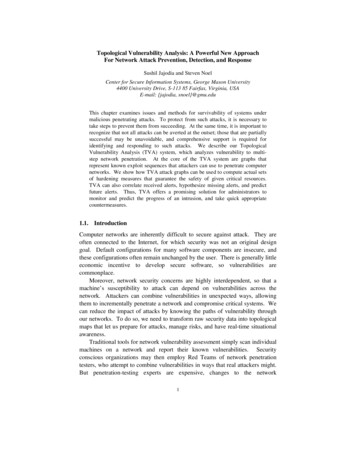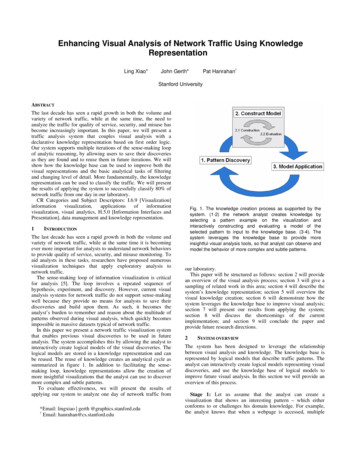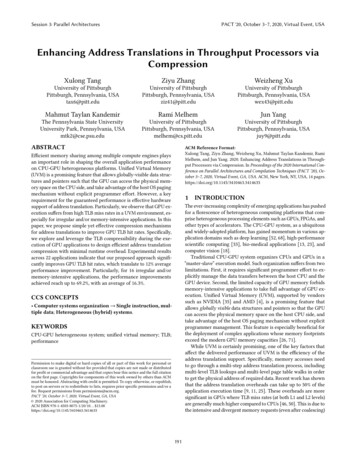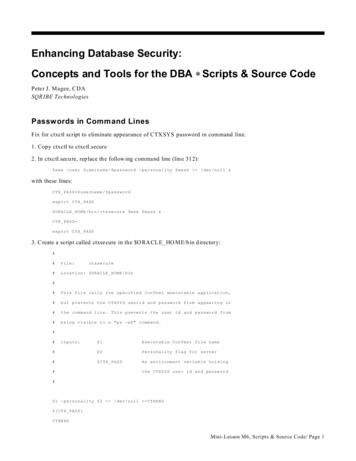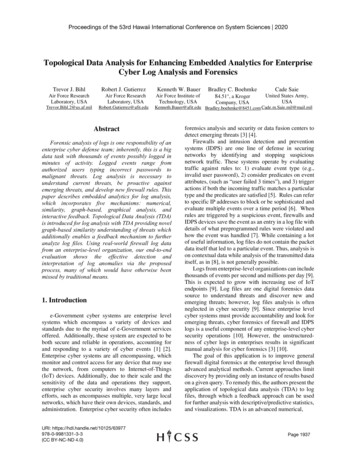
Transcription
Proceedings of the 53rd Hawaii International Conference on System Sciences 2020Topological Data Analysis for Enhancing Embedded Analytics for EnterpriseCyber Log Analysis and ForensicsTrevor J. BihlAir Force ResearchLaboratory, USATrevor.Bihl.2@us.af.milRobert J. GutierrezKenneth W. BauerAir Force ResearchLaboratory, USAAir Force Institute ofTechnology, USARobert.Gutierrez@afit.eduCompany, USACade SaieUnited States Army,USAKenneth.Bauer@afit.edu Bradley.boehmke@8451.com Cade.m.Saie.mil@mail.milAbstractForensic analysis of logs is one responsibility of anenterprise cyber defense team; inherently, this is a bigdata task with thousands of events possibly logged inminutes of activity. Logged events range fromauthorized users typing incorrect passwords tomalignant threats. Log analysis is necessary tounderstand current threats, be proactive againstemerging threats, and develop new firewall rules. Thispaper describes embedded analytics for log analysis,which incorporates five mechanisms: numerical,similarity, graph-based, graphical analysis, andinteractive feedback. Topological Data Analysis (TDA)is introduced for log analysis with TDA providing novelgraph-based similarity understanding of threats whichadditionally enables a feedback mechanism to furtheranalyze log files. Using real-world firewall log datafrom an enterprise-level organization, our end-to-endevaluation shows the effective detection andinterpretation of log anomalies via the proposedprocess, many of which would have otherwise beenmissed by traditional means.1. Introductione-Government cyber systems are enterprise levelsystems which encompass a variety of devices andstandards due to the myriad of e-Government servicesoffered. Additionally, these system are expected to beboth secure and reliable in operations, accounting forand responding to a variety of cyber events [1] [2].Enterprise cyber systems are all encompassing, whichmonitor and control access for any device that may usethe network, from computers to Internet-of-Things(IoT) devices. Additionally, due to their scale and thesensitivity of the data and operations they support,enterprise cyber security involves many layers andefforts, such as encompasses multiple, very large localnetworks, which have their own devices, standards, andadministration. Enterprise cyber security often includesURI: 3(CC BY-NC-ND 4.0)Bradley C. Boehmke84.51 , a Krogerforensics analysis and security or data fusion centers todetect emerging threats [3] [4].Firewalls and intrusion detection and preventionsystems (IDPS) are one line of defense in securingnetworks by identifying and stopping suspiciousnetwork traffic. These systems operate by evaluatingtraffic against rules to: 1) evaluate event type (e.g.,invalid user password), 2) consider predicates on eventattributes, (such as “user failed 3 times”), and 3) triggeractions if both the incoming traffic matches a particulartype and the predicates are satisfied [5]. Rules can referto specific IP addresses to block or be sophisticated andevaluate multiple events over a time period [6]. Whenrules are triggered by a suspicious event, firewalls andIDPS devices save the event as an entry in a log file withdetails of what preprogrammed rules were violated andhow the event was handled [7]. While containing a lotof useful information, log files do not contain the packetdata itself that led to a particular event. Thus, analysis ison contextual data while analysis of the transmitted dataitself, as in [8], is not generally possible.Logs from enterprise-level organizations can includethousands of events per second and millions per day [9].This is expected to grow with increasing use of IoTendpoints [9]. Log files are one digital forensics datasource to understand threats and discover new andemerging threats; however, log files analysis is oftenneglected in cyber security [9]. Since enterprise levelcyber systems must provide accountability and look foremerging threats, cyber forensics of firewall and IDPSlogs is a useful component of any enterprise-level cybersecurity operations [10]. However, the unstructuredness of cyber logs in enterprises results in significantmanual analysis for cyber forensics [3] [10].The goal of this application is to improve generalfirewall digital forensics at the enterprise level throughadvanced analytical methods. Current approaches limitdiscovery by providing only an instance of results basedon a given query. To remedy this, the authors present theapplication of topological data analysis (TDA) to logfiles, through which a feedback approach can be usedfor further analysis with descriptive/predictive statistics,and visualizations. TDA is an advanced numerical,Page 1937
Figure 1. Generic representation of an enterprise-level data collection hierarchy, from [3].graph-based, and visual analytics approach thatsimultaneously considers similarity and shape of thedata [11].While TDA has been proposed for cyber networkanalysis [12] [13] [14], it has yet to be applied forfirewall logs. The closest application of TDA to loganalysis is that of Chow [15], who applied TDA toWindows event logs from the BRAWL (Blue versusRed Agent War-game Evaluation) project. However, thework in [15] considered synthetic cyber data, aconstrained and experimental environment, and couldnot find direct value in applying TDA to cyber data.Additionally, Coudriau et al. [14] applied TDA tonetwork address data, but the data was not high invariety as typically found in logs. This paper thusillustrates the first application of TDA to real-worldcollected firewall logs from a large enterprise system, aswell as the incorporation of TDA into a big dataanalytics platform for batch analysis of cyber logs.Beyond these contributions, the results also address thelimitations of using TDA mentioned in [15].Analytics by themselves can be brittle; of interest inthis paper is proposing and employing a combinedexperiential and analytical approach to log forensicsthrough the data-driven, user-friendly embeddedanalytics platform. Herein, statistical and visualmethods are combined into an embedded application.For this, the authors leverage their past work [3] in cyberanalytics and employ a tabulated feature vector (TFV)approach to process log files and identify anomalies. Inthe TFV approach, log files are divided into temporalblocks and analysts are cued to blocks of interest. TDAextends this by looking at similarity across blocks, inaddition to a further feedback loop process. The keycontributions from this paper are: The first application of TDA to log analysis Development of a human-machine approach that ly-based that incorporates feedback Combination of statistical and visual methods foroutlier/anomaly detection and interpretationAn evaluation of the developed approach on realenterprise log files on data consistent with [3].2. BackgroundBig data, such as network traffic, can be processedas batches or streams. Batches are collected and thenprocessed whereas streams are analyzed in real-time ornear real-time [16]. Firewalls and IDPS systemsconsider streaming data wherein rules are applied tonetwork traffic [6]. In contrast, digital forensicsconsiders aggregated data in a batch process to findthreats and develop new firewall/IDPS rules [17].A general enterprise level data collection approachis conceptualized in Figure 1. At enterprise systems, rawlogs are normalized into a structured file at a givenfacility, then forwarded to a Regional Center (RC)which both collects data and defends against cyberthreats [18]. At the RCs, a regional Security Informationand Event Management (SIEM) device aggregates,correlates, monitors and generates alerts from thereceived data. Data is then sent and aggregated frommultiple regional SIEMs and sent to a global SIEM. Theglobal SIEM then connects to cyber analysis.In Figure 1, the big data platform can be consideredas a centralized database for managing and analyzingbig data [3]. Here, both structured and unstructured datais collected with high volume, variety, and velocity, the3 V’s [19], from which data can be queried andanalyzed. Of interest is looking for understanding andinterpretation of events that would have triggered a logentry; such understanding can be gained by developingembedded analytics methods that analysts can run toanalyze log files and provide interpretations.2.1. Cyber Forensics AnalyticsPage 1938
Fundamental to statistical data analysis, colloquiallyknown as analytics, is the use of algorithms to findpatterns [20]. Analytics methods range from supervised,with known classes/groups in the data (e.g. malignantand benign), to unsupervised, where classes/groups areunknown and need to be discovered (e.g. discovery ofnew groupings). Supervised analytics in cyber couldinclude determining how similar observations are toknown threats based on classifier algorithms.Unsupervised analytics, e.g. clustering, are especiallyrelevant in cyber since the dynamic nature of cyberevents means new threats are constantly emerging.Problematically, normal behavior for cybernetworks constantly changes and conservativeapproaches are often pursued which yield securesystems with high false positive detection rates [21].Such systems could hamper authorized use of networks,furthering the importance of identifying actual threats.In analyzing log files, one is essentially interested in 1)detecting the anomalies within the anomalies, and 2)finding emerging threats via forensic analysis.Two general approaches exist for cyber log forensicsanalytics: experiential/qualitative and analytical/quantitative. Experiential cyber log forensics uses cyberanalysts who rely on manual sorting and experientiallygained knowledge to find possible threats for furtherinvestigation [3]. Such approaches are heavily effectiveand make use of the innate ability of humans to processlarge amounts of complex data [20]; however, big datachallenges make it impossible to analyze all dataeffectively and novice analysts might miss events thatveteran analysts would not [22]. Additional issuesinclude the asymmetrical nature of cyber-attacks whereattackers can focus on one approach while defendersmust protect all systems from many different types ofattacks, vulnerabilities, and threats [23].To solve this problem, various analytical methodshave been proposed to analyze logs [24]. Log analyticsmethods include both high level approaches, such asanomaly detection [25] [26], text analytics [27],dynamic rule creation [28], and event correlation [24],to the application of specific algorithms such as supportvector machines [29], random forests [30], principalcomponent analysis (PCA) and factor analysis (FA) [3].However, analytics by themselves can be brittle. Ofinterest in this paper is proposing and employing acombined experiential and analytical approach to logforensics through a data driven embedded application.2.2. Big Cyber Log DataDue to the large size of enterprise networks andquantity of users, the data is of significant volume andemerging at high velocity; i.e. a big data problem. Witha wide variety of devices at use in enterprise networks,each observation to the log can be highly variable fromthe others with the some logged fields being sparse dueto differing approaches used at Regional SIEMs.Traditionally, analysts employed experientialapproaches to digital forensics where large log files aremanually sorted to find anomalies to further investigate.However, inspecting numerous potential incidents on adaily basis is not scalable. The work in [3] extended themanual process to develop an embedded analytics toolthat examines an entire log file and provides tools to findnovelty, anomalies, and contextual meaning in a log.Notably, the authors in [31] recently proposed a similarprocess to that of [3]. Herein, we extend upon [3] withmore advanced analytics as well as a feedback approach.Due to sparsity, this research focuses on a reducedset of collected log fields, listed in Table 3. These fieldswere selected based on i) commonality between datafields logged by Regional SIEMS and ii) demonstratingstatistical approaches to log file analysis withoutincorporating text mining techniques. Redundant fieldsfrom Regional SIEMs, e.g. Device Vendor andDevice Product, were also grouped avoid confusion.Table 3. Dataset VariablesField NameDevice VendorDevice ProductSource AddressDestination AddressTransport ProtocolBytes InBytes OutCategory OutcomeCountry NameDescriptionCompany who made the deviceName of the security deviceIP address of the sourceIP address of the destinationTransport protocol usedNumber of bytes transferred inNumber of bytes transferred outAction taken by the deviceCountry of the source IP address2.3. Tabulated Feature Vectors (TFVs)Tabulated feature vector (TFV) extraction getsaround difficulties handling mixed and sparse data andfacilitates the use of statistical methods for log data. Themethod proposed by Winding et al. [32], and furtherapplied in [3] takes log files and aggregatesobservations. The resultant feature vector is a count ofoccurrences of unique values and columns [32].Figure 2 presents a conceptualization of the TFVprocess. In Figure 2a a conceptual raw log file is shownwhich include both categorical/text (Field A) andnumerical (Field B) data columns. The process to createa TFV involves i) condensing text fields into columns ofunique counts, and ii) summations of the originalnumerical values, which results in the TFV seen inFigure 2b. Naturally, this method can be extended todifferent fields, categories, etc., with the result being aTFV of length dictated by the complexity of the log file.The process in Figure 2 would result in oneobservation, or row, if one applied it to an entire log file.Page 1939
Thus, the TFVs are most useful if they divide the logfiles into blocks and then compute feature vectors foreach block. Notably,
consider streaming data wherein rules are applied to network traffic [6]. In contrast, digital forensics considers aggregated data in a batch process to find threats and develop new firewall/IDPS rules [17]. A general enterprise level data collection approach is conceptualized in Figure 1. At enterprise systems, raw
